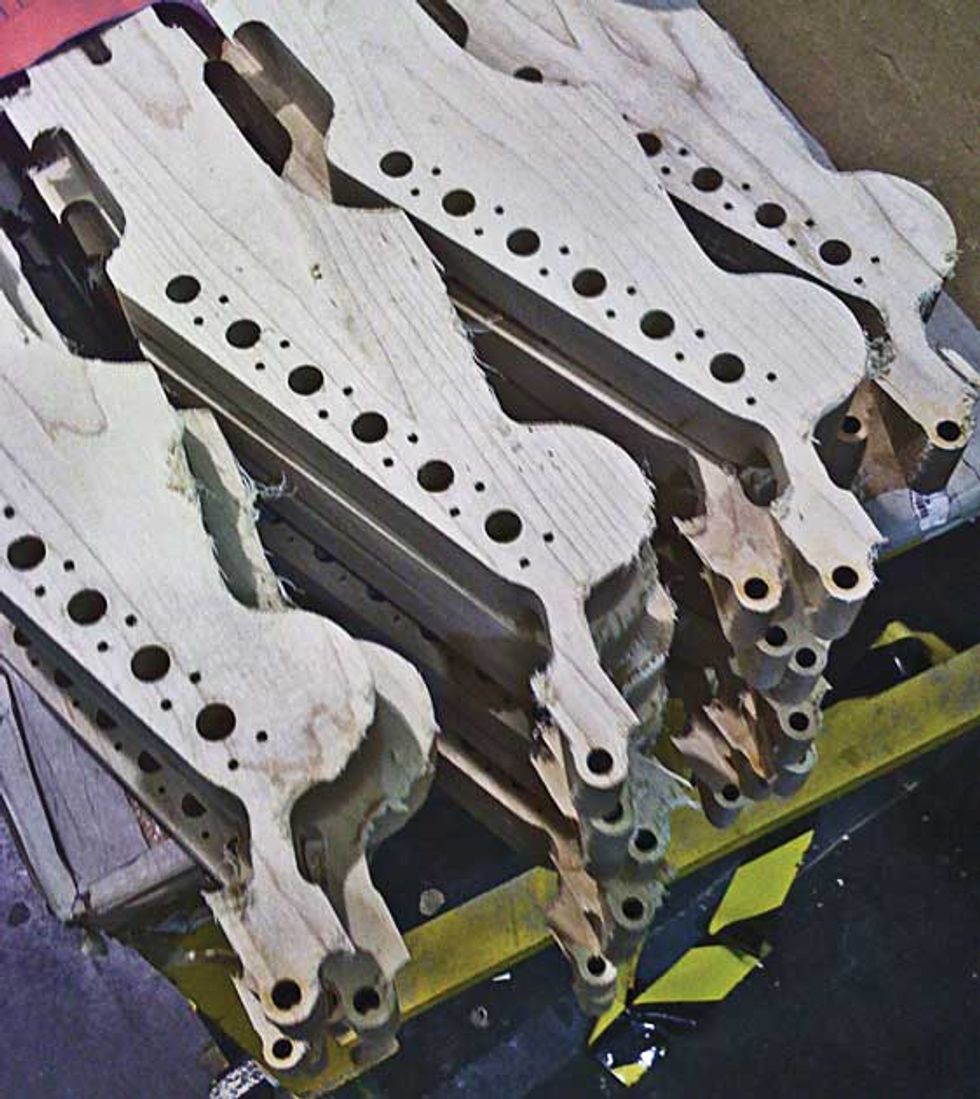Unless you’ve been living under a discarded accordion in the basement of a VFW hall, you probably know that this year marks the 60th anniversary of the Stratocaster. Undoubtedly one of the greatest achievements of mankind, it has been one of my favorite guitars since, well, forever. I was barely 2 years old when this triple-pickup wonder arrived on the planet and displaced me as the center of the universe. I believe my first words were, “I want a Strat.”
The fact that almost every guitarist of consequence eventually gravitates to one isn’t why I admire it. It’s not because its sonorous cluck and quack is instantly recognizable on a recording. Nor is it the Stratocaster’s voluptuous curves and flashing chrome that earns my unfaltering allegiance. It’s because of simplicity.
Yes, there are plenty of guitars that are more plain or unadorned. There are more utilitarian designs like its older sibling Telecaster. But for downright genius, easy-to-make-in-huge-quantities simple, the boys in Fullerton laid the puck in the crease when they conjured up the Stratocaster. Every aspect of this instrument was agonizingly scrutinized for ease of manufacture, and I don’t believe it has ever been bested.
As we observe our specimen from headstock to output jack, there are no wasted opportunities for corner cutting because every shortcut has been anticipated.
The neck is made from a single piece of 1" flatsawn maple—a material that is plentiful, cheap, and extremely durable. The bottom surface of the board is both the back of the headstock and the heel of the neck. This means that a shaper knife or router needs only to be run on the shaft of the neck to bring it to final shape. And instead of pitching the headstock backwards as on classical instruments, the necessary downward string pressure is accomplished by removing half of the material on the front of the peghead area.
A slot for the truss rod is routed down the center of the back of the board. There is a simple hole at each end and no need for a truss rod cover. Instead of a platform for the nut, a simple slot does just fine. The individual necks are easy to maneuver in the spray booth and a breeze to buff. At the assembly stage, the six-on-a-side configuration is beneficial in that an inventory of identical tuners can be held instead of two sets, as on three-on-a-side designs. Handy.
Moving our eyes to the curvaceous body, we may note how the light plays upon sultry lines that mimic the human form. The Strat’s comfy arm bevel and tummy rout (attributed to a suggestion made by Western swing guitarist Bill Carson) are not just concessions to coziness for the player. Introducing curved surfaces helps to hide irregular finishing results and masks grain sinking. Painting curved surfaces is much easier as the surface tension holds the paint in suspension. The blunt rounds where sides meet top and back are extremely forgiving to both the spray painter and the buffer.
Finishing a guitar is not only one of the longest and costliest operations in guitar building. It’s also the point in the process where a builder has the most to lose from mistakes and accidents in the buffing stage. A master buffer learns to avoid sharp edges that can catch the wheel and “burn” through the finish, which requires a touch up or even a strip and finish do-over. These errors can easily happen around routs for pickups, tremolo mechanisms, and output jacks. Leo certainly understood this, and he designed overlapping covers to hide all these areas: a flanged edge on the output jack, a tremolo-cover plate on the back, and the pickguard itself for the front.
Speaking of the Stratocaster’s pickguard, it is the magnum opus of efficiency. It’s the assembly template and cover all-in-one, and the soldering can be done ahead of time and in the open instead of working down in a hole. Grab a prefab assembly off the shelf, pop it on, and screw it down—fini.
With the neck and body completed, it’s a simple matter to set the neck into the body pocket and insert four screws from the back. The neck is set up high enough for the strings to clear the pickups and bridge without resorting to any neck pitch. There are no wacky angles to cut or match from one part to another like there is with violin-style guitar building. This paragraph’s brevity shows how simple the idea is: It’s pure genius.
The patented tremolo bridge stands as the instrument’s most complicated element, but its bent-steel components are brilliant in their simplicity as individual parts. Leo loved those punch presses. I think adding the trem was another Bill Carson idea, but Leo had to do things his way, so Paul Bigsby's influence is most evident in the peghead shape. Still, the mounting of the Strat’s bridge is a true model of simplicity. The only thing left off was a way to lock it, which was addressed a few years later on the Jazzmaster.
All of this speaks to why the mighty Stratocaster is the most copied guitar design on the planet. Sure, it sounds wonderful (even when you set one on fire and chuck it at a full stack), but that’s only part of why it endures. It’s not due to its legendary toughness in battle or its uncanny ability to make you instantly attractive to audiences. I suggest that our beloved Strat has been flattered with imitation millions of times because it is so easy to make. And that makes me like it even more.














![Rig Rundown: Russian Circles’ Mike Sullivan [2025]](https://www.premierguitar.com/media-library/youtube.jpg?id=62303631&width=1245&height=700&quality=70&coordinates=0%2C0%2C0%2C0)







